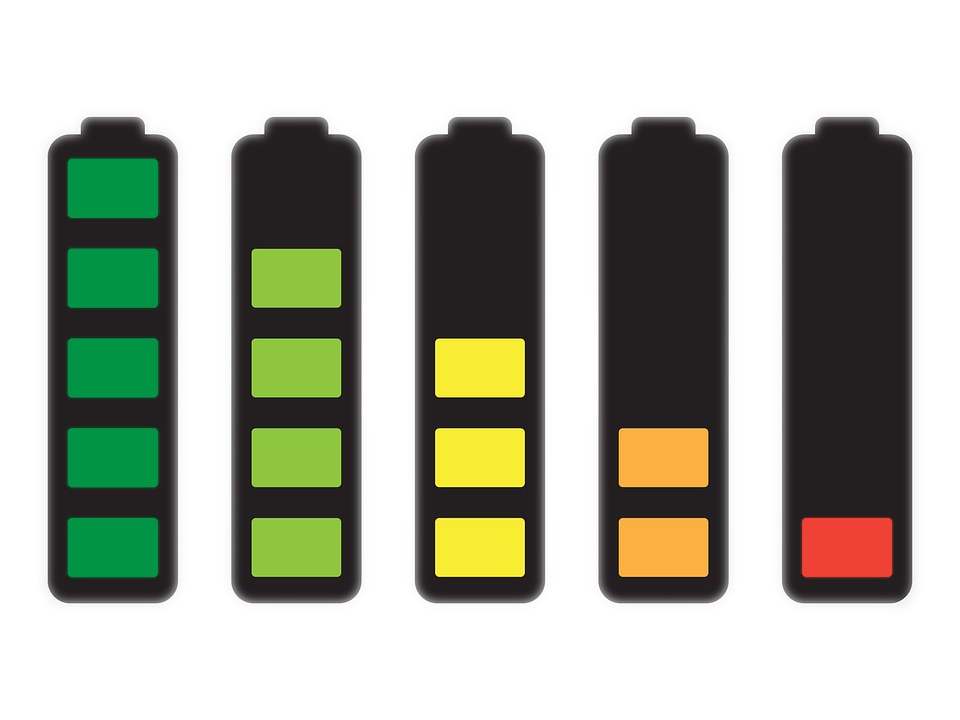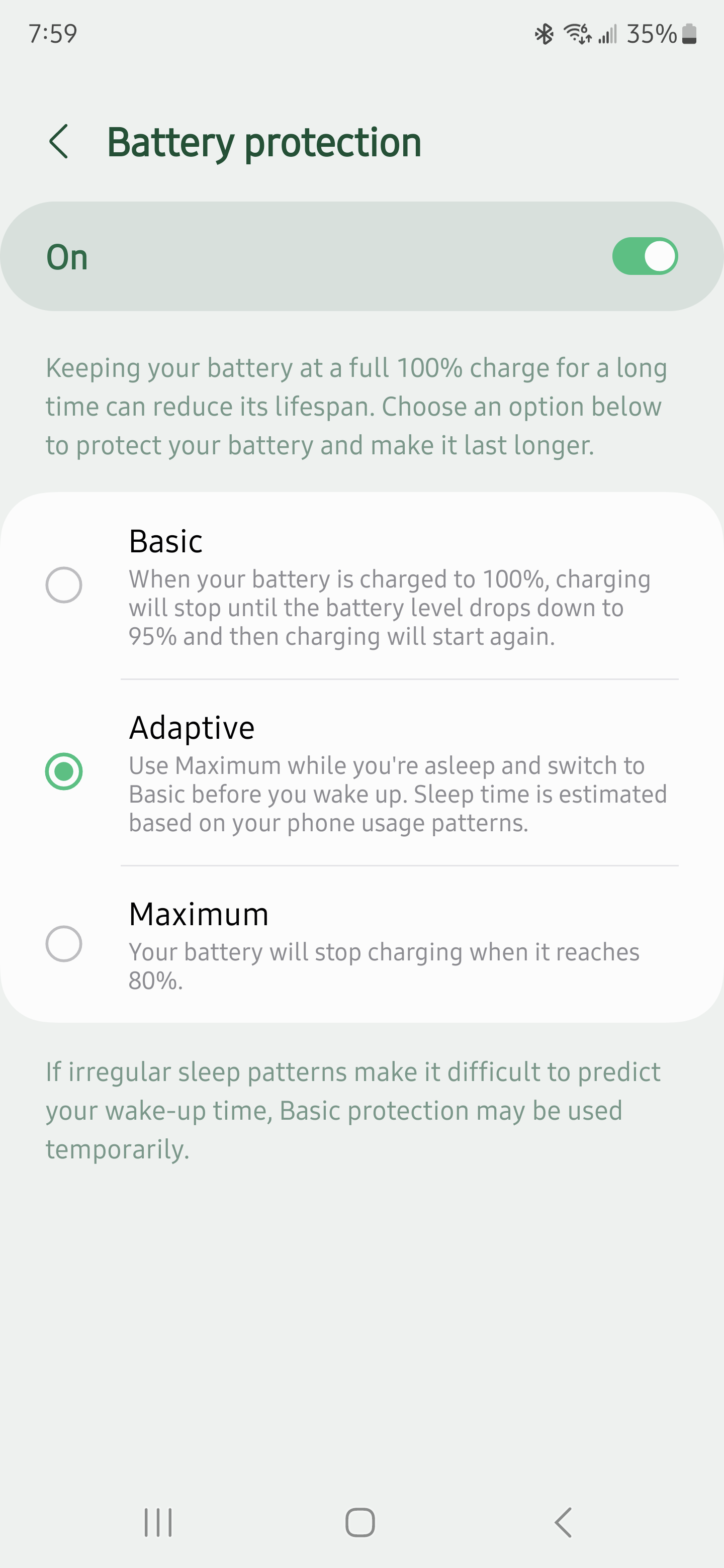I’m convinced that apples laptop battery saver feature that’s AI powered and decides when to charge above 80% vs just letting you set it to 80% and manually set it to 100% when needed is to cause the batteries to die sooner, because ITS GOD AWFUL AT DOING ITS JOB PROPERLY.
I have a Dell Laptop (Latitude 7390) where I changed in the bios some option to maximize battery longevity and 6 years later it still lasts quite a lot.
I have a POS HP from nine years ago and the battery still lasts two hours. Just depends on the battery size I guess
Damn, some of you must have pretty chill lives if paying attention to what level your battery charge is at DAILY is something you want to add to your plates. I mean sure, if there was a setting that allowed you to have the phone automatically cut charging at 80% this might be worth thinking about. But when I charge my phone its during times when I dont have to think about it (Aka 90% of the time, when I’m asleep)
I’ve stopped charging my phone overnight which I typically advise people against but also keep a charger at my desk. My phone actually has a battery saver setting that cuts charging at 85%.
Overnight is literally the easiest and most natural slot to do so. Whether or not its most optimal is not whats important, I’ll just seek out brands that aknowledge this reality and build their hardware and software around this
What kind of phone do you have. Samsing, Apple and Pixel all have solutions.
The used prixel I got recently automatically only charges to 80% if an alarm is set, then charges the rest of the way to hit 100% when the alarm goes off.
My pixel (5a) only does adaptive charging if your alarm is set for the A.M. If you’re second or third shift, it doesn’t even try. There’s no way to turn it on even in developer options. It was a pretty big wtf when I figured that one out.
Its more I’m lazy. I’m on a ROG Phone 3, and as a gaming phone it probably has that feature. I’m moreso just arguing that if this is still an issue batteries face, tech should address it and fin solutions for how to get around the most common form of charging which is plugging it in and doing something else, which inherently means you ARENT watching what charge its at and have little control over when it stops charging
True, of course the simplest and easiest solution is the one that takes the least amount of thinking and effort.
My only issue is there are brands that try to build around this but it’s incredibly difficult. I understand iPhones have some kind of smart charging that’s supposed to charge slowly but stop until it learns when it thinks you’ll need it and finish charging just before then. However, that relies on consistent data and consistent routine and I would think that could potentially be quite inaccurate if you have a more inconsistent routine. I don’t think I’ve seen a better implementation yet unfortunately.
It’s just become second nature to me to watch for and charge my phone so certain times. I feel like that’s just a part of owning a mobile device.
Yeah, thats kind of my point. Plugging your phone in every night when you go to bed is a pretty natural and low thought way of charging any electronic device
My phone has exactly this (oneplus 9 pro) but it works only when there is a full moon and the next Friday is the thirteen’s day of the month, plus some other unknown requirements
I’ve a one plus Nord 2 5g and it has optimised charging at night but it doesn’t come on every night I charge it and it does feel like there’s some arcane shit needed for it to work at times.
Samsung has this option, called Battery Protect I think. There’s also the Accubattery app which will set an alarm to go off once it reaches 80 pct. I’m with you though, unless the phone itself shuts off charging, it’s too much to manage even with an alarm.
S23 Ultra: Protect Battery - 85 percent toggle
I tried it before but my anxiety was always going . Thinking to try again.
Leaving a battery at 100% over a long time wasn’t recommended but I would imagine most devices have BMS settings to deal with this now.
The chemistry from holding that last 20% of charge for a while is what causes the degradation. The BMS can tell the system to stop charging before it’s full but it can’t do anything itself to prevent the cell from slowly being degraded by full charging.
This is is a problem that occurs on the order of years and that’s why the EV companies care but phones historically don’t. More easily replaceable batteries is the real solution here, not software stopping you from fully charging.
It is not the “real solution”. Increasing the battery longevity is much more sustainable than regularly replacing the battery, and is therefore the most rational and responsible course of action.
I have a new laptop that was complaining that I’d had it plugged in too long. Apparently there’s a battery management setting that will have it charge to 80% max. I’ve used laptops exclusively for like 15 years and this is the first one to complain about being plugged in constantly.
I would imagine most devices have BMS settings to deal with this now.
There’s not much incentive to do that. Battery longevity reduces sales. Keeping the battery at 100% gives better review scores. It’s a lose lose for phone makers to implement that.
All BMSs I’ve come across have this disabled by default sadly, manufacturers seem to target longest device runtime, rather than extended battery longevity
On my FP3 it needs to be enabled in a terminal, while rooted (newer devices have it in the settings).
On my Steam Deck it also needs to be enabled in a terminal, the exact command differs depending on the model of steam deck. An embedded developer or tinkerer will find it very quickly in the kernel sysfs though.
Edit: Apple and Lenovo are the only companies I’m aware of, who have historically cared for the internal batteries in certain models of their laptops. Macbook Pros in particular used to behave differently when they reach 90%, some will stop charging and others will wait a few hours then resume charging to 100% depending on how the machine is used. I assume this is the only reason why my 2012 MBP still is going great on its original battery, running Linux of course.
Lenovo used to let you configure the charge preferences in the BIOS of their ThinkPad line
This was a decade ago though, can’t vouch for whether this applies to the modern stuff too
Laptop folks reading this - check your bios settings. My recent Dell (and I’m sure other brands are similar) has options for this. It has a “usually plugged in” setting, but I manually chose to limit charging to 80%, which is an option in the same place.
Obv if this is bad for your use case, don’t do it.
My lenovo legion laptop lets me limit charging to 60% for maximum battery longevity
I do this myself. I have mine set to 81% as the max and get a notification when it hits that level and then I get another notification when it hits 30% so I can plug it in.
not going to trust a website that makes money from repairing phones
also a lot of armchair battery scientists in here
iFixit has been pushing phone repairability and right to repair for years. Sure, that makes it easier for them make repairs, but it also helps users repair their own devices. For example, in the article they mention their stance that phones should have removable batteries so that instead of having to take a phone in to get the battery repaired or replaced, you can just swap it yourself. Personally, I want to use my device as long as possible before I’m forced to buy a new one, so I’m happy to have more ways to fix issues myself.
They also have a shit ton of guides on their website that show step by step how to make various repairs, and they are free.
IFixit aren’t the bad guys here
I want to correct you but I like it better that way. I want to be an armchair battery scientist when I grow up.
Specifically batteries for armchairs. Yeah that’d be a dope title.
I’m an actual battery scientist. They wear out much more slowly if you don’t charge them all the way
If it shouldn’t be charged above 80%, then make 80% the new 100%. “But this one goes to 11”
A lot of charging circuits and battery designs already do this transparently.
Yes. Batteries are bags of chemicals. They don’t really have percentages. Where you decide 100% is is somewhat arbitrary and up to the battery management.
What the system shows the user may be even a completely different number and there may be software adjustable values.
It’s inherently a made up number and a manufacturer can decide to be more brutal or more sparing in how they treat the chemicals.
They already did. The percentage range on your phone’s battery display is basically a usable range rather than an absolute range. The article talks about phone manufacturers making changes to their charging systems to optimize battery function, but the headline bit about not charging past a certain point has been taken into account by Android and iOS for ages.
Very few android phones actually have this feature, most manufacturers strip it
At the risk of sounding like Spinal Tap, why don’t they just make the chargers stop at 80% and have the interface show 100%?
Edit: woops. Appears that’s already a thing.
Sony phones have a setting called Battery Care that lets you choose 80%, 90% or 100% as the max.
Degraded battery life is rarely the thing that tanks a device for me (sure, it degrades, but it’s rarely the reason I replace it). I mean it’s great to know about this, but the last four phones I’ve replaced have been because (a) my old phone didn’t work on my new network, (b) my camera failed, © my chipset wasn’t up to the task of the most recent OS update, and (d) there was a fundamental flaw in my handset and the manufacturer offered a $50 upgrade to their newer model with trade.
Actually, thinking about it, a and b might be switched, but the point stands: it’s probably been twenty years since battery life was the reason I upgraded (from a flip phone to another flip phone, iirc).
Thanks for sharing
If 80% is enough, there is not much to loose that is usually wäre the battery health finds its plateau after some years. I rather change my battery once it hits 80% health after two years. I don’t want to use it like it would behave when the battery is already dead.
deleted by creator
It’s not paranoia, it’s an issue of how Li-ion batteries work.
Literally. It even extends to other Lithium based chemistries too, like LiFePo4.
It’s not like this information is hiding either - ask a battery manufacturer/distributor for a Li-ion cell’s charge cycle data, what you’ll find is most manufacturers only guarantee 300-500 cycles before the battery has lost 80% of its usable capacity at 100% DoD and charging to the 100% SoC voltage. Decreasing just the maximum SoC to 90% brings massive battery longevity gains, where estimated cycles increase to 1000 (and beyond in some cases), while still retaining over 80% of the battery’s usable capacity.
All my personal devices that I’ve checked sadly target 100% SoC voltage and charge rate, without regard for the longevity of the battery. Just seems almost like they’ve just punched in the numbers from the “ABSOLUTE MAX RATINGS” part of the datasheet and called it a day.
It’s a little disappointing that a lot of people are under the belief that their product has been designed to last as long as it can, when in most cases this intentionally or accidentally isn’t the case right now, in industries outside of backup power and EVs
I hear the same argument about EVs, where many charge to 80%. Sometimes you need that extra juice, and by all means use it. Other times you’re only going to the grocery store, or sitting at your desk all day, and you can stay plugged in and you don’t really need that 20%. It’s no real skin off your nose either way.
Then, years from now when you need as much energy as your battery can give, you haven’t lost it to degradation and you really haven’t lost much along the way.
Why wait 10 years to get a 20% battery degradation when you can have it today!?
I very rarely need a full charge when I get a new phone. Battery rarely drops under 50% unless it’s a heavy use day. However, that same phone 3 years later will be causing me issues because the battery doesn’t last through the day.
I would happily trade off 20% max battery in the first few years, to get a healthier battery 4 years down the line.
I just charge my phone to full when it’s at like 20 and then unplug it when it’s done charging. Have had this phone for like 2 and a half years and I don’t have noticeable degradation, but it’s a flagship samsung phone so I know they typically have pretty good cells in them.
My Galaxy s22 has an option “battery protection” that limits my battery charging to 85%. Looks like they had a good idea there.
Same here. Battery still feels like new nearly 2 years later, and I use it as a GPS damn near 40 hours a week on top of normal usage. I like to run my phones into the ground these days, and the battery is almost always the first to go. Looks like I’ll be getting at least another 3 or 3 years out of this one.
I didn’t realize I had this option. Thanks so much!
On the S24, it actually changed to 80%. I also turned off fast charging when charging overnight at home.
I believe that’s because google added it too and theirs was set to 80%
Yep, no need to fast charge if it has all night
My samsung n20 ultra has the 85% charge option built in and I’ve always used it to keep my battery good. Back when it was easier to use custom roms in the 2010-2014 Era there was a lost of them that had custom “stop charging options” like it.
I also have fast/ultra fast charging disabled. If you don’t need to quickly charge your phone, it’s something else you should avoid.
For steam deck owners it gets a bit more complicated. SD has pass through charging, so once the battery is fully charged and also while it is plugged in, you aren’t powering it through the battery like cell phones and most laptops do. It’s just running off the USB c power, so if you usually play while plugged in, you aren’t cycling the battery, but you are having to allow it to fully charge.
SD has pass through charging, so once the battery is fully charged and also while it is plugged in, you aren’t powering it through the battery like cell phones and most laptops do.
That’s how nearly all modern devices work. Li-Ion can’t be charged and discharged simultaneously. There is circuitry to split the power between the battery and the device when it’s being charged.
Cheaper devices will just stop charging when you use them or they won’t work at all when plugged in.
This is flat out not true for most phones. Most phones will charge to 100% and continously charge/discharge if still plugged in. Over the last couple years there’s been some phones that will allow pass through/bypass charging. Iphones don’t do it at all. Only some android phones.
They talk about Apple but Sony phones have had this feature for a while. In the settings you can choose whether the phone is always 100% charged, or whether it charges to 80% (or a custom %) or whether you want it full by the time you wake up.
I use the 3rd option. It stops charging when it gets to 90% and I tell it when I’m getting up, and just before it will charge up to 100 %.
Best of both worlds. Only ever having 80% to start is not nice because you get less juice during the day and need to charge by the evening. Plus battery anxiety. I’d rather have a 100% full battery.
Clearly newer, better battery tech is needed. Plus replaceable batteries.
Samsung, too.
I use it because I want my phone to last as long as possible, but the downside is that it won’t last a day so I have to charge in between. Ironic, isn’t it?
Very ironic.
That’s why I just tell it to be full by morning because I purposely bought a phone with a great battery . Why would I want to hamper it by 20%???
I know plenty of devices will stop charging when the battery is optimal and just say it’s at 100% even though it’s 80.
Samsung has a setting for 85%, i know my phone only charging to 85% does not get as hot.




















